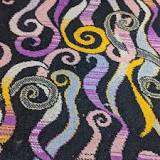Yamaha's SEQTRAK looks like a return to fun mobile music designs - CDM Create Digital Music

It’s an FM/sample-based synth, sampler, drum machine, and connected music maker. And most noticeably, it sees Yamaha return to the kinds of fun design we associate with 80s Yamaha and Casio.
This honestly looks a lot like what a Yamaha PortaSound or Casio SK-1 would be if you had modern tech. So, yes, Teenage Engineering has prominently made a stab at reviving some of the candy bar magic of vintage Casio with the OP-1, OP-Z, and OP-1 Field. But let’s look further back, because this also recalls 80s Yamaha and Casio, right down to the bright colors and internal speaker. Of course, that all benefits from the latest digital innards because look at what’s inside:

- 4-operator FM synth with 8-voice polyphony
- AWM2 – “Advanced Wave Memory 2” engine with 128-note polyphony – see below, it’s basically a combination of PCM sample memory and a modeled virtual analog architecture
- 800 MB preset memory, plus 500 MB user memory
- Stereo sampling at 44.1 K / 24-bit
- Internal MEMS microphone (again, thank James West) and line input sampling capability
- Wi-Fi, Bluetooth connectivity
- MIDI in/out (wait, “only included cable can be used”?! We’ll see about that!)
- Effects/filters with a flexible architecture: “Reverb × 12 types, Delay × 9 types, Master Effect × 85 types, Single Effect × 85 types, Master EQ 5 bands, LP-HP filters for each track” (also apparently from the AWM2 engine, but have to double-check that)
- Step sequencer with keys
- USB-C for power, MIDI, and audio
- Internal battery with 3-4 hours continuous use


All of this as a slightly awkwardly-named “Mobile Music Ideastation.” (It really needs some archaic model designation, like SQKTRK-7892Z.”
Yamaha SEQTRAK
$599 MSRP. It’s available in both a white-and-orange color scheme, or if you hate fun / tend to get things covered in dirt, black and gray.
And the street price appears to be $/EUR 399. Available from major resellers as a preorder:
If you buy something from a CDM link, we may earn a commission.
Yamaha SEQTRAK Music Creation Station [Guitar Center]
Yamaha Seqtrak Mobile Music Ideastation [Sweetwater]
That’s a nicely rounded-out set of features. There’s also accessibility for loading more samples and managing projects on a connected SEQTRAK app, though fortunately it looks like this is also perfectly usable standalone without it. (And that, of course, was the major drawback of the OP-Z.)
I do have a lot of remaining questions – this is not a review, just a preview. I mean, there are definitely some peculiar interface design choices there on the panel. Consistent access to levels for each instrument part is potentially good, but it seems normally you’d prefer to have the encoders on the left for parameter access and just deal with mutes, presumably. That’s opposed to whatever is going on here (and I truly don’t know what is going on here… DUCKER OTHER MIXER SONG):

But I do look forward to checking it out. And evidently, in short, you can sequence together melodies, chords, and beats, add your own samples including from the internal mic, use sample-based or FM synthesis (as this is Yamaha), and have fun. And it’s still got a nice complement of buttons and encoders for some knobby hands-on action, plus enough sample memory.
That’s a Li-Ion battery, so don’t put this in checked luggage (it’s a fire hazard there), but this looks like one to use on the tray table anyway.

And it also leverages higher-end tech from Yamaha – so it’s not the stripped-down feature set of Roland’s recent portable entries or the increasingly long-in-the-tooth KORG volca series. AWM2 is straight out of the Montage and MODX+ ranges. On those instruments, in addition to being able to play back samples, AWM2 has “18 different filter types, amplitude, pitch and filter envelope generators, nine LFOs, 3-band EQ and a dedicated dual insert effect with Virtual Circuitry Modeling.” It’s unclear how much of that architecture is accessible here; that’ll require a review. Hopefully at least the modeled filters have made it.
Here’s a walkthrough of how it works:
Our friend Mijk van Dijk has a nice hands-on performance:
It’s also been a long time since we saw Yamaha take this kind of risk – remember when the company did a global campaign for the Tenori-On?
But step back in time with me because the real predecessor for this design, historically speaking, is not the OP-1 or OP-Z, and not even the SK-1. It’s the Philips PMC 100. That design came from Lyndsay Williams, who seems to have spent her entire career ahead of her time. (She worked on the PMC 100, sound accessories for the Spectrum and Commodore 64, the Psion PDA, haptics, and pen input, plus work running research at Microsoft. And you’ll like this – she started inventing sample solutions when she couldn’t afford a Fairlight CMI.)
Okay, to understand the connection between the PMC 100 and the Seqtrak, first remove all the obvious 80s details – yeah, the cassette recorder interface and membrane keyboard don’t exactly hold up. But this did manage to incorporate two-operator FM as found on Yamaha’s PortaSound range, an LCD screen (the one detail missing from the new Yamaha), and a complete step sequencer, plus audio recording. All of that was enabled by a new custom chip, the MSI823, built with Yamaha’s FM.
And yes, both have a microphone enabled by a 1962 breakthrough at Bell Labs as I wrote about yesterday.
mu:zines has a review from its 1988 debut. Here’s a detailed look at how it worked:
And the trick is to add a knob?
And yeah, that 2-op FM chip was grimy. as. hell.
All of this is to say, just look what you can do with modern chips, batteries, and internal storage. And clearly, Teenage Engineering has paved the way by demonstrating musicians can embrace design cues outside of the usual music gear world.
Let’s refer back to that design, actually. (It does remind me of the issues TE had with the finish, seeing this video, but there was a lot accomplished on the OP-Z.) The basic slim form factor for portability, built-in mic and speaker, minijack I/O, wireless connectivity with companion app, and even details like side-mounted buttons and color LEDs and mounting are all there. (I’m going to say it looks a bit like the OP-Z with a latest-gen KORG electribe as its cousin.) So part of why we’ll really have to test the Yamaha is, it’s down to how Yamaha has done with their engine and interactions.
I’m keen to try this one, for sure.


 United Kingdom
United Kingdom Argentina
Argentina  Australia
Australia  Austria
Austria  Brazil
Brazil  Canada
Canada  Germany
Germany  Ireland
Ireland  Italy
Italy  Malaysia
Malaysia  Mexico
Mexico  New Zealand
New Zealand  Poland
Poland  South Africa
South Africa  United States
United States 


















